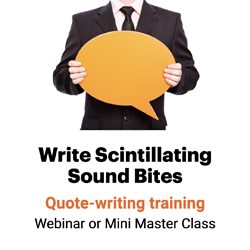Help clients put in a good word for you
Too often, communicators use first-party testimonials. That is, they quote their own VP of product development on how great the new product is.

Hey! We know you think your product or service is great. But can’t you find anyone who agrees with you?
Instead, add third-party testimonials — those from people outside your organization — to your PR and marketing communications.
Testimonials work because of something communication theorists call The Peer Principle of Persuasion. That is, if I believe it worked for someone else, I’m more likely to believe it will work for me.
“What others say about you and your product, service, or business is at least 1,000 times more convincing than what you say, even if you are 2,000 times more eloquent.”
— Dan Kennedy, author of No B.S. Sales Success
That’s why Amazon’s customer reviews are so helpful. I know that if Orbiting the Giant Hairball was helpful to other business communicators, it will probably also be helpful to me.
Customer quotes, testimonials and case studies build trust among potential customers, boost conversion rates and add depth to your content marketing, social media and media relations pieces. Whether you use video testimonials or a testimonials page on your website, this technique is one of the best ways to reach potential clients.
Bottom line: If you’re not using testimonials, you’re missing a key element of successful PR and marketing campaigns.
Here are six techniques for crafting effective testimonials for your PR and marketing pieces:
1. Work with your sales and service teams.
These folks are closest to your customers. That means they’re most likely to be able to identify potential sources of customer testimonials and case studies … and to help you convince customers to speak up for your company.
Need an influencer testimonial for social proof? Reach out to the folks who influence the influencers.
2. Stop whining and pick up the phone.
Whenever I talk about testimonials in a writing workshop, someone is bound to say, “Great idea; won’t work here.” Their customers would never agree to give a testimonial, they say. Then one of their colleagues shares her success stories about getting customer quotes.
At one company, after much bitching and moaning over how utterly impossible it was to get customer comments, a shy junior communicator said she found the company’s database of testimonials helpful in her work.
Her colleagues were so busy complaining, they hadn’t bothered to lift their heads to find that some enterprising communicators had not only figured out how to get testimonials, but had archived lots of them into an intranet site.
The best way to get testimonials? Ask.
It is true that it is nearly impossible to get testimonials if you never ask for them. So stop kvetching and pick up the phone.
3. Look beyond customers.
Client testimonials are great. But industry analysts, the media and other observers can also speak out for your organization.
USAA Life Insurance Company, for instance, turned to its clip files for testimonials such as:
“A handful of insurers sell low-load policies by phone, among them … USAA in San Antonio. Their cash values grow faster … during your investment’s early years.”
— Newsweek
“One company that rates high on fixed annuity lists is USAA Life in San Antonio.”
— The New York Times
“USAA delivers Rolls Royce service at Chevette prices.”
— Smart Money
USAA also included its top ratings from A.M. Best, Standard & Poor’s and Moody’s Investor Service — testimonials of a kind — in the same brochure.
Get great testimonials from your customers, of course. But who else can speak to the benefits of your organization’s products, services and ideas?
4. Write your own testimonials.
Interview your customers, then craft their comments into a quote for their review.
5. Be specific.
“Easy to work with” won’t hurt; “helped us increase revenues by 27%” will definitely help. Focus on bottom-line business results, and use a number whenever possible.
Testimonials are business writing. Numbers are the language of business.
6. Write a three-sentence case study.
Go beyond Sally Fields testimonials: “They like us, they really like us.” Instead, write mini case studies for your testimonials. They’re the most effective type of testimonial out there.
To write a case-study testimonial, cover:
- The problem the customer faced
- The solution your organization offered
- The results of the efforts
Applause, the employee kudos magazine of Walgreens, included these three case-study testimonials in a recent issue.
Monica saves the day.
The customer writes:
Notice the problem-solution-results storytelling structure here:
- Problem: They gave me the wrong prescription.
- Solution: Monica intervened.
- Result: She saved my life.
It was a dark and stormy night.
The customer writes:
Notice the problem-solution-results structure behind this mini story:
- Problem: I arrived after closing.
- Solution: Staff invited me in anyway.
- Results: They’re not stated here, but obvious. Prompt your customers to “finish” the story with one sentence about how the solution affected them.
Love that David.
The customer writes:
This is the least successful testimonial of the three, because it doesn’t use the storytelling structure. Still, it’s effective because of the specific details and the bold opinion about the competition.
Take a tip from Applause editors, and push for testimonials that tell little stories instead of just using adjectives like “helpful” and “high-quality.”
In their own words …
With all these techniques for developing and using customer quotes, why not use testimonials in your marketing and business communications?

Leave a Reply